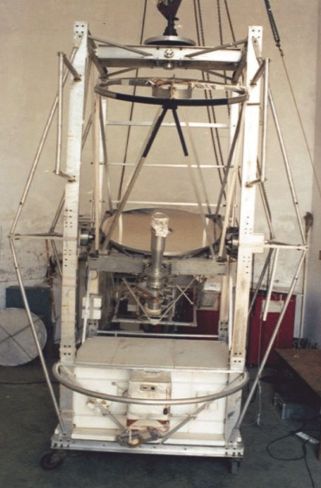Purpose of the flight and payload description
FPS100 was the denomination of a balloon-borne instrument for astronomical observations in the far-infrared domain of the spectrum. It was composed by a 1 meter diameter telescope (T100) developed by the Tata Institute of Fundamental Research (TIFR) from India coupled with a Fabry Perot Spectrometer (FPS) developed by the Institute of Space and Astronautical Science (ISAS) and Nagoya University from Japan. Both instruments performed several balloon missions over India starting in 1999.
In the image at left we have a general view of the instrument (click to enlarge).
The T100 Telescope
The telescope employed an f/8 Cassegrain system with a solid-aluminum primary mirror of 1 meter of diameter and an undersized secondary with a central hole to minimize the signal due to chopping of the primary mirror edges and its central hole.
The telescope was stabilized in the two orthogonal axis which were nominally normal to the optic axis, namely in the elevation (EL) and cross-elevation (XEL) axes; the error signals for the servo-system were provided by a star tracker and a pair of orthogonal rate gyros. Servo-control for the azimuthal axis was also used to avoid the limitation arising from the small angular freedom for the cross-elevation axis. The star tracker had a 1.4º field of view and was capable of acquiring stars of B magnitude brighter than 5. Further, the star tracker could be offset with respect to the telescope axis up to 4.5º in both the elevation and cross-elevation axes. A photomultiplier in the focal plane of the telescope viewed a 2.5º field which was offset by 9' in cross-elevation with respect to the infrared field. This was sensitive to stars of magnitude < 9 and could be used for aspect calibration using stars close to the infrared field.
The telescope could be operated in either a pointing mode or a raster scan mode; the amplitude and the speed along the lines of scan (in crosselevation) and the steps in elevation and/or crosselevation at the end of each scan line could be selected by radio commands.
The Fabry Perot Spectrometer
The FPS was a tandem Fabry Perot Spectrometer, which was installed at the focal plane of the T100 telescope. It consisted of two Fabry Perot interferometers: one a high order interferometer with movable plates to scan the wavelength (Scanning Fabry Perot; SFP) and the other a low-order interferometer with fixed plates (Fixed Fabry Perot; FFP) which acted as an order sorter for the SFP. The two interferometers together with other optics of the spectrometer and the FIR detector, were cooled to 2 K using liquid helium. The FIR detector used was a stressed Germanium-Gallium (Ge:Ga) photoconductor.
Details of the balloon flight
Balloon launched on: 2/5/2009
Launch site: TIFR National Balloon Facility, Hyderabad, India
Balloon launched by: National Balloon Facility, Tata Institute of Fundamental Research
Balloon manufacturer/size/composition: Zero Pressure Balloon 143.400 m3
End of flight (L for landing time, W for last contact, otherwise termination time): 2/5/2009
Balloon flight duration (F: time at float only, otherwise total flight time in d:days / h:hours or m:minutes - ): F 3 h 10 m
Landing site: Nalgonda, Andhra Pradesh, India
Payload weight: 1196.4 kgs
External references
- Balloon launch records Tata Institute of Fundamental Research
10360If you consider this website interesting or useful, you can help me to keep it up and running with a small donation to cover the operational costs. Just the equivalent of the price of a cup of coffee helps a lot.



